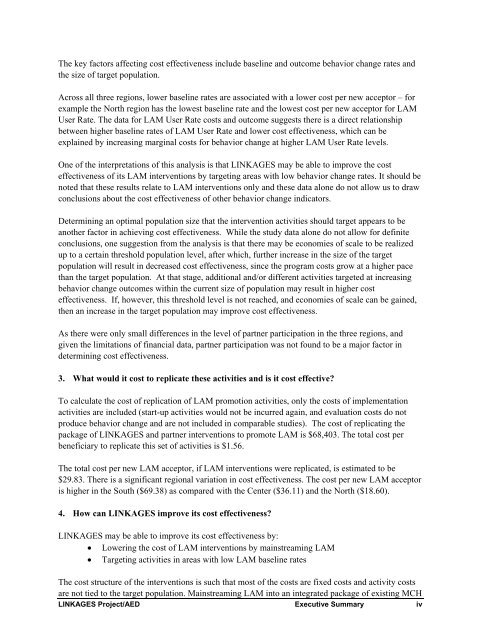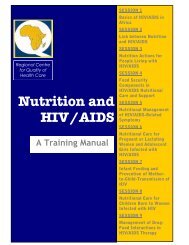Cost and Effective Analysis of the LINKAGES ... - Linkages Project
Cost and Effective Analysis of the LINKAGES ... - Linkages Project
Cost and Effective Analysis of the LINKAGES ... - Linkages Project
You also want an ePaper? Increase the reach of your titles
YUMPU automatically turns print PDFs into web optimized ePapers that Google loves.
The key factors affecting cost effectiveness include baseline <strong>and</strong> outcome behavior change rates <strong>and</strong><strong>the</strong> size <strong>of</strong> target population.Across all three regions, lower baseline rates are associated with a lower cost per new acceptor – forexample <strong>the</strong> North region has <strong>the</strong> lowest baseline rate <strong>and</strong> <strong>the</strong> lowest cost per new acceptor for LAMUser Rate. The data for LAM User Rate costs <strong>and</strong> outcome suggests <strong>the</strong>re is a direct relationshipbetween higher baseline rates <strong>of</strong> LAM User Rate <strong>and</strong> lower cost effectiveness, which can beexplained by increasing marginal costs for behavior change at higher LAM User Rate levels.One <strong>of</strong> <strong>the</strong> interpretations <strong>of</strong> this analysis is that <strong>LINKAGES</strong> may be able to improve <strong>the</strong> costeffectiveness <strong>of</strong> its LAM interventions by targeting areas with low behavior change rates. It should benoted that <strong>the</strong>se results relate to LAM interventions only <strong>and</strong> <strong>the</strong>se data alone do not allow us to drawconclusions about <strong>the</strong> cost effectiveness <strong>of</strong> o<strong>the</strong>r behavior change indicators.Determining an optimal population size that <strong>the</strong> intervention activities should target appears to beano<strong>the</strong>r factor in achieving cost effectiveness. While <strong>the</strong> study data alone do not allow for definiteconclusions, one suggestion from <strong>the</strong> analysis is that <strong>the</strong>re may be economies <strong>of</strong> scale to be realizedup to a certain threshold population level, after which, fur<strong>the</strong>r increase in <strong>the</strong> size <strong>of</strong> <strong>the</strong> targetpopulation will result in decreased cost effectiveness, since <strong>the</strong> program costs grow at a higher pacethan <strong>the</strong> target population. At that stage, additional <strong>and</strong>/or different activities targeted at increasingbehavior change outcomes within <strong>the</strong> current size <strong>of</strong> population may result in higher costeffectiveness. If, however, this threshold level is not reached, <strong>and</strong> economies <strong>of</strong> scale can be gained,<strong>the</strong>n an increase in <strong>the</strong> target population may improve cost effectiveness.As <strong>the</strong>re were only small differences in <strong>the</strong> level <strong>of</strong> partner participation in <strong>the</strong> three regions, <strong>and</strong>given <strong>the</strong> limitations <strong>of</strong> financial data, partner participation was not found to be a major factor indetermining cost effectiveness.3. What would it cost to replicate <strong>the</strong>se activities <strong>and</strong> is it cost effective?To calculate <strong>the</strong> cost <strong>of</strong> replication <strong>of</strong> LAM promotion activities, only <strong>the</strong> costs <strong>of</strong> implementationactivities are included (start-up activities would not be incurred again, <strong>and</strong> evaluation costs do notproduce behavior change <strong>and</strong> are not included in comparable studies). The cost <strong>of</strong> replicating <strong>the</strong>package <strong>of</strong> <strong>LINKAGES</strong> <strong>and</strong> partner interventions to promote LAM is $68,403. The total cost perbeneficiary to replicate this set <strong>of</strong> activities is $1.56.The total cost per new LAM acceptor, if LAM interventions were replicated, is estimated to be$29.83. There is a significant regional variation in cost effectiveness. The cost per new LAM acceptoris higher in <strong>the</strong> South ($69.38) as compared with <strong>the</strong> Center ($36.11) <strong>and</strong> <strong>the</strong> North ($18.60).4. How can <strong>LINKAGES</strong> improve its cost effectiveness?<strong>LINKAGES</strong> may be able to improve its cost effectiveness by:• Lowering <strong>the</strong> cost <strong>of</strong> LAM interventions by mainstreaming LAM• Targeting activities in areas with low LAM baseline ratesThe cost structure <strong>of</strong> <strong>the</strong> interventions is such that most <strong>of</strong> <strong>the</strong> costs are fixed costs <strong>and</strong> activity costsare not tied to <strong>the</strong> target population. Mainstreaming LAM into an integrated package <strong>of</strong> existing MCH<strong>LINKAGES</strong> <strong>Project</strong>/AED Executive Summary iv
















